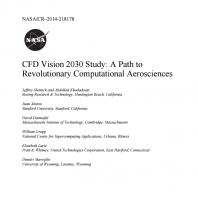
CFD Vision 2030 Study: A Path to Revolutionary Computational Aerosciences

Executive Summary (excerpt)
This report represents the findings and recommendations of a multidisciplinary team that was assembled in response to a NASA Research Announcement (NRA) with the goal of formulating a knowledge-based forecast and research strategy for developing a visionary CFD capability in the notional year 2030. The diverse team members bring together deep expertise in the areas of aerodynamics, aerospace engineering, applied mathematics, and computer science, and the team includes members with extensive experience from industry, academia, and government. A multipronged strategy was adopted for gathering information and formulating a comprehensive research plan. Input from the broader international technical community was sought, and this was obtained initially through the development and compilation of an online survey that garnered more than 150 responses. As a follow-up, a workshop was held with academic, industrial, and government participants from the general aerospace engineering community with a stake in simulation-based engineering. The results from the survey and workshop were synthesized and refined by the team, with considerable additions through internal discussions and feedback from sponsoring NASA officials. The overall project spanned a period of 12 months and resulted in a series of findings, a vision for the capabilities required in the year 2030, and a set of recommendations for achieving these capabilities.
- Issues:
- Infrastructure, Technological innovation
- Regions:
- Global, North America
- Country:
- United States
- Year Published:
- 2014
- Authors:
- Jeffrey Slotnick, Abdollah Khodadoust, Juan Alonso, David Darmofal, William Gropp, Elizabeth Lurie, Dimitri Mavriplis
- Institution:
- NASA

